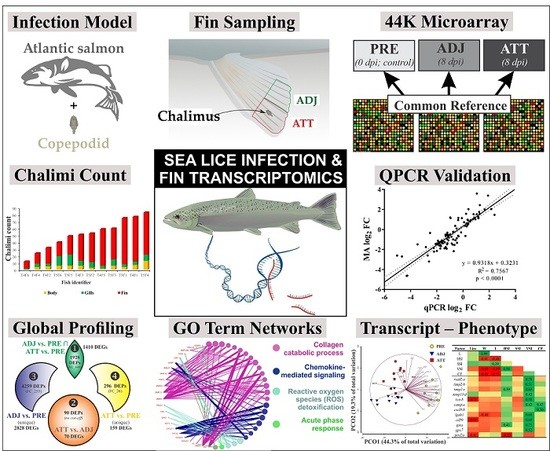Transcriptomic Profiling in Fins of Atlantic Salmon Parasitized with Sea Lice: Evidence for an Early Imbalance Between Chalimus-Induced Immunomodulation and the Host’s Defense Response
Abstract
1. Introduction
2. Results
2.1. Sea Lice Load in Salmon
2.2. Global Transcriptomic Changes in Response to Chalimus Attachment
2.3. Enriched Gene Ontology (GO) Terms Associated with DEPs
2.4. GO/Pathway Term Networks Associated with DEGs
2.5. Identification of Dysregulated Pathways
2.6. Chalimus-Responsive, Differentially Expressed Transcripts among Different Fin Sample Groups
2.7. QPCR Confirmation of Selected Transcripts
2.8. Multivariate and Correlation Analyses Based on Gene Expression and Phenotype Data
3. Discussion
3.1. Chalimus Infection Influences Transcription Machinery, Energy Metabolism, and Melanin Biosynthesis
3.2. Sea Lice Modulate ECM Integrity and Catabolism, Wound Repair, Inflammation, Acute Phase Response, and Coagulation
3.3. Chalimus-Induced Changes in O2 Transport and Redox Homeostasis
3.4. Impact of Lice Infection on Expression of Immune-Relevant Transcripts
3.4.1. Pattern Recognition Receptors (PRRs)
3.4.2. Cytokine/Chemokine Signaling
3.4.3. Complement Pathway
3.4.4. Antiviral Responses
3.4.5. Miscellaneous Elements in Innate Immunity
3.4.6. Adaptive Immunity
3.5. Relationship Between Transcript Expression and Lice Load
3.6. Compromised Immune System by Lice
4. Materials and Methods
4.1. Ethics Statement
4.2. Experimental Animals
4.3. Sea Lice Infection and Sampling
4.4. RNA Extraction, DNA Digestion, and Column Purification
4.5. Microarray Experiment: Design, Hybridization, and Data Acquisition
4.6. Microarray Data Analysis
4.7. GO Term Enrichment Test, Analyses and Visualization of GO/Pathway Term Networks and Expression Profiles
4.8. Real-Time Quantitative Polymerase Chain Reaction (QPCR) Confirmation
4.9. Statistical Analyses
5. Conclusions
Supplementary Materials
Author Contributions
Funding
Acknowledgments
Conflicts of Interest
References
- Aaen, S.M.; Helgesen, K.O.; Bakke, M.J.; Kaur, K.; Horsberg, T.E. Drug resistance in sea lice: A threat to salmonid aquaculture. Trends Parasitol. 2015, 31, 72–81. [Google Scholar] [CrossRef] [PubMed]
- Costello, M.J. Ecology of sea lice parasitic on farmed and wild fish. Trends Parasitol. 2006, 22, 475–483. [Google Scholar] [CrossRef] [PubMed]
- Costello, M.J. The global economic cost of sea lice to the salmonid farming industry. J. Fish Dis. 2009, 32, 115–118. [Google Scholar] [CrossRef] [PubMed]
- Johnson, S.C.; Bravo, S.; Nagasawa, K.; Kabata, Z.; Hwang, J.; Ho, J.; Shih, C. A review of the impact of parasitic copepods on marine aquaculture. Zool. Stud. 2004, 43, 229–243. [Google Scholar]
- Torrissen, O.; Jones, S.; Asche, F.; Guttormsen, A.; Skilbrei, O.T.; Nilsen, F.; Horsberg, T.E.; Jackson, D. Salmon lice—Impact on wild salmonids and salmon aquaculture. J. Fish Dis. 2013, 36, 171–194. [Google Scholar] [CrossRef]
- The State of World Fisheries and Aquaculture 2018—Meeting the Sustainable Development Goals; FAO: Roma, Italy, 2018; ISBN 978-92-5-130562-1.
- Torrissen, O.; Olsen, R.E.; Toresen, R.; Hemre, G.I.; Tacon, A.G.J.; Asche, F.; Hardy, R.W.; Lall, S. Atlantic Salmon (Salmo salar): The “Super-Chicken” of the Sea? Rev. Fish. Sci. 2011, 19, 257–278. [Google Scholar] [CrossRef]
- Sutherland, B.J.; Koczka, K.W.; Yasuike, M.; Jantzen, S.G.; Yazawa, R.; Koop, B.F.; Jones, S.R. Comparative transcriptomics of Atlantic Salmo salar, chum Oncorhynchus keta and pink salmon O. gorbuscha during infections with salmon lice Lepeophtheirus salmonis. BMC Genom. 2014, 15, 200. [Google Scholar] [CrossRef]
- Fast, M.D.; Ross, N.W.; Mustafa, A.; Sims, D.E.; Johnson, S.C.; Conboy, G.A.; Speare, D.J.; Johnson, G.; Burka, J.F. Susceptibility of rainbow trout Oncorhynchus mykiss, Atlantic salmon Salmo salar and coho salmon Oncorhynchus kisutch to experimental infection with sea lice Lepeophtheirus salmonis. Dis. Aquat. Org. 2002, 52, 57–68. [Google Scholar] [CrossRef]
- Johnson, S.C.; Fast, M.D. Interactions between sea lice and their hosts. In Host-Parasite Interactions; Taylor & Francis: Abingdon, UK, 2004; pp. 131–159. [Google Scholar]
- Hamre, L.A.; Eichner, C.; Caipang, C.M.A.; Dalvin, S.T.; Bron, J.E.; Nilsen, F.; Boxshall, G.; Skern-Mauritzen, R. The salmon louse Lepeophtheirus salmonis (Copepoda: Caligidae) life cycle has only two chalimus stages. PLoS ONE 2013, 8, e73539. [Google Scholar] [CrossRef]
- Figueroa, C.; Bustos, P.; Torrealba, D.; Dixon, B.; Soto, C.; Conejeros, P.; Gallardo, J.A. Coinfection takes its toll: Sea lice override the protective effects of vaccination against a bacterial pathogen in Atlantic salmon. Sci. Rep. 2017, 7, 17817. [Google Scholar] [CrossRef]
- Barker, S.E.; Bricknell, I.R.; Covello, J.; Purcell, S.; Fast, M.D.; Wolters, W.; Bouchard, D.A. Sea lice, Lepeophtheirus salmonis (Krøyer 1837), infected Atlantic salmon (Salmo salar L.) are more susceptible to infectious salmon anemia virus. PLoS ONE 2019, 14, e0209178. [Google Scholar] [CrossRef] [PubMed]
- Purcell, S.; Friend, S.; Covello, J.; Donkin, A.; Groman, D.; Poley, J.; Fast, M. CpG inclusion in feed reduces sea lice, Lepeophtheirus salmonis, numbers following re-infection. J. Fish Dis. 2013, 36, 229–240. [Google Scholar] [CrossRef] [PubMed]
- Jodaa Holm, H.; Wadsworth, S.; Bjelland, A.K.; Krasnov, A.; Evensen, O.; Skugor, S. Dietary phytochemicals modulate skin gene expression profiles and result in reduced lice counts after experimental infection in Atlantic salmon. Parasit. Vectors 2016, 9, 271. [Google Scholar] [CrossRef] [PubMed]
- Burka, J.F.; Hammell, K.L.; Horsberg, T.; Johnson, G.R.; Rainnie, D.; Speare, D.J. Drugs in salmonid aquaculture–a review. J. Vet. Pharm. 1997, 20, 333–349. [Google Scholar] [CrossRef]
- Raynard, R.S.; Bricknell, I.R.; Billingsley, P.F.; Nisbet, A.J.; Vigneau, A.; Sommerville, C. Development of vaccines against sea lice. Pest Manag. Sci. 2002, 58, 569–575. [Google Scholar] [CrossRef]
- Igboeli, O.O.; Burka, J.F.; Fast, M.D. Lepeophtheirus salmonis: A persisting challenge for salmon aquaculture. Anim. Front. 2014, 4, 22–32. [Google Scholar] [CrossRef]
- Bjordal, A. Sea lice infestation on farmed salmon: Possible use of cleaner-fish as an alternative method for de-lousing. Can. Tech. Rep. Fish. Aquat. Sci. 1990, 1761, 85–89. [Google Scholar]
- Brooks, K.M. Considerations in developing an integrated pest management programme for control of sea lice on farmed salmon in Pacific Canada. J. Fish Dis. 2009, 32, 59–73. [Google Scholar] [CrossRef]
- Mayer, L. Cooke Invests in Green Tech to Combat Sea Lice. Available online: https://www.aquaculturenorthamerica.com/cooke-invests-in-green-tech-to-combat-sea-lice-1922/?jjj=1557420024556 (accessed on 26 April 2018).
- Field Testing “Green-Technology” Sea Lice Traps and Documenting on-Site Dynamics of Sea Lice Early Life History. Available online: www.dfo-mpo.gc.ca/aquaculture/rp-pr/acrdp-pcrda/projects-projets/M-12-01-001-eng.html (accessed on 5 May 2017).
- Skugor, S.; Glover, K.A.; Nilsen, F.; Krasnov, A. Local and systemic gene expression responses of Atlantic salmon (Salmo salar L.) to infection with the salmon louse (Lepeophtheirus salmonis). BMC Genom. 2008, 9, 498. [Google Scholar] [CrossRef]
- Tadiso, T.M.; Krasnov, A.; Skugor, S.; Afanasyev, S.; Hordvik, I.; Nilsen, F. Gene expression analyses of immune responses in Atlantic salmon during early stages of infection by salmon louse (Lepeophtheirus salmonis) revealed bi-phasic responses coinciding with the copepod-chalimus transition. BMC Genom. 2011, 12, 141. [Google Scholar] [CrossRef]
- Robledo, D.; Gutierrez, A.P.; Barria, A.; Yanez, J.M.; Houston, R.D. Gene Expression Response to Sea Lice in Atlantic Salmon Skin: RNA Sequencing Comparison Between Resistant and Susceptible Animals. Front. Genet. 2018, 9, 287. [Google Scholar] [CrossRef] [PubMed]
- Krasnov, A.; Skugor, S.; Todorcevic, M.; Glover, K.A.; Nilsen, F. Gene expression in Atlantic salmon skin in response to infection with the parasitic copepod Lepeophtheirus salmonis, cortisol implant, and their combination. BMC Genom. 2012, 13, 130. [Google Scholar] [CrossRef] [PubMed]
- Jantzen, S.G.; Sanderson, D.S.; von Schalburg, K.R.; Yasuike, M.; Marass, F.; Koop, B.F. A 44K microarray dataset of the changing transcriptome in developing Atlantic salmon (Salmo salar L.). BMC Res. Notes 2011, 4, 88. [Google Scholar] [CrossRef] [PubMed][Green Version]
- Eslamloo, K.; Xue, X.; Hall, J.R.; Smith, N.C.; Caballero-Solares, A.; Parrish, C.C.; Taylor, R.G.; Rise, M.L. Transcriptome profiling of antiviral immune and dietary fatty acid dependent responses of Atlantic salmon macrophage-like cells. BMC Genom. 2017, 18, 706. [Google Scholar] [CrossRef]
- Eslamloo, K.; Kumar, S.; Caballero-Solares, A.; Gnanagobal, H.; Santander, J.; Rise, M.L. Profiling the transcriptome response of Atlantic salmon head kidney to formalin-killed Renibacterium salmoninarum. Fish Shellfish Immunol. 2020, 98, 937–949. [Google Scholar] [CrossRef]
- Bron, J.E.; Sommerville, C.; Jones, M.; Rae, G.H. The settlement and attachment of early stages of the salmon louse, Lepeophtheirus salmonis (Copepoda: Caligidae) on the salmon host, Salmo salar. J. Zool. 1991, 224, 201–212. [Google Scholar] [CrossRef]
- Tusher, V.G.; Tibshirani, R.; Chu, G. Significance analysis of microarrays applied to the ionizing radiation response. Proc. Natl. Acad. Sci. USA 2001, 98, 5116–5121. [Google Scholar] [CrossRef]
- Bindea, G.; Mlecnik, B.; Hackl, H.; Charoentong, P.; Tosolini, M.; Kirilovsky, A.; Fridman, W.-H.; Pagès, F.; Trajanoski, Z.; Galon, J. ClueGO: A Cytoscape plug-in to decipher functionally grouped gene ontology and pathway annotation networks. Bioinformatics 2009, 25, 1091–1093. [Google Scholar] [CrossRef]
- Shannon, P.; Markiel, A.; Ozier, O.; Baliga, N.S.; Wang, J.T.; Ramage, D.; Amin, N.; Schwikowski, B.; Ideker, T. Cytoscape: A software environment for integrated models of biomolecular interaction networks. Genome Res. 2003, 13, 2498–2504. [Google Scholar] [CrossRef]
- Drier, Y.; Sheffer, M.; Domany, E. Pathway-based personalized analysis of cancer. Proc. Natl. Acad. Sci. USA 2013, 110, 6388–6393. [Google Scholar] [CrossRef]
- Jones, S.R.M. The occurrence and mechanisms of innate immunity against parasites in fish. Dev. Comp. Immunol. 2001, 25, 841–852. [Google Scholar] [CrossRef]
- Johnson, S.; Albright, L. Comparative susceptibility and histopathology of the response of naive Atlantic, chinook and coho salmon to experimental infection with Lepeophtheirus salmonis (Copepoda: Caligidae). Dis. Aquat. Org. 1992, 14, 179–193. [Google Scholar] [CrossRef]
- Treasurer, J.W.; Wadsworth, S.L. Interspecific comparison of experimental and natural routes of Lepeophtheirus salmonis and Caligus elongatus challenge and consequences for distribution of chalimus on salmonids and therapeutant screening. Aquac. Res. 2004, 35, 773–783. [Google Scholar] [CrossRef]
- Braden, L.M.; Barker, D.E.; Koop, B.F.; Jones, S.R.M. Comparative defense-associated responses in salmon skin elicited by the ectoparasite Lepeophtheirus salmonis. Comp. Biochem. Physiol. Part D Genom. Proteom. 2012, 7, 100–109. [Google Scholar] [CrossRef]
- Braden, L.M.; Koop, B.F.; Jones, S.R. Signatures of resistance to Lepeophtheirus salmonis include a TH2-type response at the louse-salmon interface. Dev. Comp. Immunol. 2015, 48, 178–191. [Google Scholar] [CrossRef] [PubMed]
- Fast, M.D.; Sims, D.E.; Burka, J.F.; Mustafa, A.; Ross, N.W. Skin morphology and humoral non-specific defence parameters of mucus and plasma in rainbow trout, coho and Atlantic salmon. Comp. Biochem. Physiol. Part A Mol. Integr. Physiol. 2002, 132, 645–657. [Google Scholar] [CrossRef]
- Glasauer, S.M.K.; Neuhauss, S.C.F. Whole-genome duplication in teleost fishes and its evolutionary consequences. Mol. Genet. Genom. 2014, 289, 1045–1060. [Google Scholar] [CrossRef]
- Lien, S.; Koop, B.F.; Sandve, S.R.; Miller, J.R.; Kent, M.P.; Nome, T.; Hvidsten, T.R.; Leong, J.S.; Minkley, D.R.; Zimin, A. The Atlantic salmon genome provides insights into rediploidization. Nature 2016, 533, 200. [Google Scholar] [CrossRef]
- Seifert, A.; Werheid, D.F.; Knapp, S.M.; Tobiasch, E. Role of Hox genes in stem cell differentiation. World J. Stem Cells 2015, 7, 583–595. [Google Scholar] [CrossRef]
- Kachgal, S.; Mace, K.A.; Boudreau, N.J. The dual roles of homeobox genes in vascularization and wound healing. Cell Adhes. Migration 2012, 6, 457–470. [Google Scholar] [CrossRef]
- Nerlov, C. The C/EBP family of transcription factors: A paradigm for interaction between gene expression and proliferation control. Trends Cell Biol. 2007, 17, 318–324. [Google Scholar] [CrossRef] [PubMed]
- Osawa, M.; Yamaguchi, T.; Nakamura, Y.; Kaneko, S.; Onodera, M.; Sawada, K.-i.; Jegalian, A.; Wu, H.; Nakauchi, H.; Iwama, A. Erythroid expansion mediated by the Gfi-1B zinc finger protein: Role in normal hematopoiesis. Blood 2002, 100, 2769–2777. [Google Scholar] [CrossRef] [PubMed]
- Barish, G.D.; Narkar, V.A.; Evans, R.M. PPAR delta: A dagger in the heart of the metabolic syndrome. J. Clin. Investig. 2006, 116, 590–597. [Google Scholar] [CrossRef] [PubMed]
- Karpe, F.; Ehrenborg, E.E. PPARdelta in humans: Genetic and pharmacological evidence for a significant metabolic function. Curr. Opin. Lipidol. 2009, 20, 333–336. [Google Scholar] [CrossRef]
- Krieg, P.; Fürstenberger, G. The role of lipoxygenases in epidermis. Biochim. Biophys. Acta 2014, 1841, 390–400. [Google Scholar] [CrossRef]
- Kittilsen, S.; Schjolden, J.; Beitnes-Johansen, I.; Shaw, J.C.; Pottinger, T.G.; Sørensen, C.; Braastad, B.O.; Bakken, M.; Øverli, Ø. Melanin-based skin spots reflect stress responsiveness in salmonid fish. Horm. Behav. 2009, 56, 292–298. [Google Scholar] [CrossRef]
- Kittilsen, S.; Johansen, I.B.; Braastad, B.O.; Øverli, Ø. Pigments, parasites and personalitiy: Towards a unifying role for steroid hormones? PLoS ONE 2012, 7, e34281. [Google Scholar] [CrossRef]
- Sveen, L.R.; Timmerhaus, G.; Krasnov, A.; Takle, H.; Handeland, S.; Ytteborg, E. Wound healing in post-smolt Atlantic salmon (Salmo salar L.). Sci. Rep. 2019, 9, 3565. [Google Scholar] [CrossRef]
- Nastase, M.V.; Young, M.F.; Schaefer, L. Biglycan: A multivalent proteoglycan providing structure and signals. J. Histochem. Cytochem. 2012, 60, 963–975. [Google Scholar] [CrossRef]
- Zhang, W.; Ge, Y.; Cheng, Q.; Zhang, Q.; Fang, L.; Zheng, J. Decorin is a pivotal effector in the extracellular matrix and tumour microenvironment. Oncotarget 2018, 9, 5480–5491. [Google Scholar] [CrossRef]
- Tufvesson, E.; Westergren-Thorsson, G. Biglycan and decorin induce morphological and cytoskeletal changes involving signalling by the small GTPases RhoA and Rac1 resulting in lung fibroblast migration. J. Cell Sci. 2003, 116, 4857. [Google Scholar] [CrossRef] [PubMed]
- Gerke, V.; Creutz, C.E.; Moss, S.E. Annexins: Linking Ca2+ signalling to membrane dynamics. Nat. Rev. Mol. Cell Biol. 2005, 6, 449–461. [Google Scholar] [CrossRef] [PubMed]
- Kumar, A.; Bhandari, A.; Sarde, S.J.; Goswami, C. Ancestry & molecular evolutionary analyses of heat shock protein 47 kDa (HSP47/SERPINH1). Sci. Rep. 2017, 7, 10394. [Google Scholar]
- Poniatowski, Ł.A.; Wojdasiewicz, P.; Gasik, R.; Szukiewicz, D. Transforming growth factor Beta family: Insight into the role of growth factors in regulation of fracture healing biology and potential clinical applications. Mediat. Inflamm. 2015, 2015. [Google Scholar] [CrossRef] [PubMed]
- Mori, T.; Kawara, S.; Shinozaki, M.; Hayashi, N.; Kakinuma, T.; Igarashi, A.; Takigawa, M.; Nakanishi, T.; Takehara, K. Role and interaction of connective tissue growth factor with transforming growth factor-β in persistent fibrosis: A mouse fibrosis model. J. Cell. Physiol. 1999, 181, 153–159. [Google Scholar] [CrossRef]
- Visse, R.; Nagase, H. Matrix metalloproteinases and tissue inhibitors of metalloproteinases: Structure, function, and biochemistry. Circ. Res. 2003, 92, 827–839. [Google Scholar] [CrossRef]
- Sproston, N.R.; Ashworth, J.J. Role of C-Reactive Protein at Sites of Inflammation and Infection. Front. Immunol. 2018, 9, 754. [Google Scholar] [CrossRef]
- Poli, V. The role of C/EBP isoforms in the control of inflammatory and native immunity functions. J. Biol. Chem. 1998, 273, 29279–29282. [Google Scholar] [CrossRef]
- Muramatsu, T. Midkine, a heparin-binding cytokine with multiple roles in development, repair and diseases. Proc. Jpn. Acad. Ser. B Phys. Biol. Sci. 2010, 86, 410–425. [Google Scholar] [CrossRef]
- Fast, M.D. Fish immune responses to parasitic copepod (namely sea lice) infection. Dev. Comp. Immunol. 2014, 43, 300–312. [Google Scholar] [CrossRef]
- Wagner, G.N.; Fast, M.D.; Johnson, S.C. Physiology and immunology of Lepeophtheirus salmonis infections of salmonids. Trends Parasitol. 2008, 24, 176–183. [Google Scholar] [CrossRef] [PubMed]
- Bayne, C.J.; Gerwick, L. The acute phase response and innate immunity of fish. Dev. Comp. Immunol. 2001, 25, 725–743. [Google Scholar] [CrossRef]
- Esmon, C.T. The interactions between inflammation and coagulation. Br. J. Haematol. 2005, 131, 417–430. [Google Scholar] [CrossRef] [PubMed]
- Braden, L.M.; Sutherland, B.J.G.; Koop, B.F.; Jones, S.R.M. Enhanced transcriptomic responses in the Pacific salmon louse Lepeophtheirus salmonis oncorhynchi to the non-native Atlantic Salmon Salmo salar suggests increased parasite fitness. BMC Genom. 2017, 18, 110. [Google Scholar] [CrossRef]
- Versteeg, H.H.; Heemskerk, J.W.; Levi, M.; Reitsma, P.H. New fundamentals in hemostasis. Physiol. Rev. 2013, 93, 327–358. [Google Scholar] [CrossRef]
- Abdel Gader, A.G.M. Tissue Factor Pathway Inhibitor [Tfpi]: A Natural Coagulation Inhibitor and Potential Therapeutic Agent—A Review. J. Taibah Univ. Sci. 2009, 4, 1–15. [Google Scholar]
- Haji Hamid, H.; Bron, J.; Shin, A.; Sommerville, C. The occurrence of blood feeding in Lepeophtheirus salmonis. In Proceedings of the Fourth International Crustacean Congress, Amsterdam, The Netherlands, 20–24 July 1998; pp. 20–24. [Google Scholar]
- Toh, S.Q.; Glanfield, A.; Gobert, G.N.; Jones, M.K. Heme and blood-feeding parasites: Friends or foes? Parasit. Vectors 2010, 3, 108. [Google Scholar] [CrossRef]
- Hood, M.I.; Skaar, E.P. Nutritional immunity: Transition metals at the pathogen–host interface. Nat. Rev. Microbiol. 2012, 10, 525. [Google Scholar] [CrossRef]
- Heggland, E.I.; Dondrup, M.; Nilsen, F.; Eichner, C. Host gill attachment enables blood-feeding by the salmon louse (Lepeophtheirus salmonis) chalimus larvae, and alters parasite development and transcriptome. bioRxiv 2019, 815316. [Google Scholar]
- Valenzuela-Muñoz, V.; Gallardo-Escárate, C. Iron metabolism modulation in Atlantic salmon infested with the sea lice Lepeophtheirus salmonis and Caligus rogercresseyi: A matter of nutritional immunity? Fish Shellfish Immunol. 2017, 60, 97–102. [Google Scholar] [CrossRef]
- He, L.; He, T.; Farrar, S.; Ji, L.; Liu, T.; Ma, X. Antioxidants maintain cellular redox homeostasis by eimination of reactive oxygen species. Cell. Physiol. Biochem. 2017, 44, 532–553. [Google Scholar] [CrossRef] [PubMed]
- Núñez-Acuña, G.; Gonçalves, A.T.; Valenzuela-Muñoz, V.; Pino-Marambio, J.; Wadsworth, S.; Gallardo-Escárate, C. Transcriptome immunomodulation of in-feed additives in Atlantic salmon Salmo salar infested with sea lice Caligus rogercresseyi. Fish Shellfish Immunol. 2015, 47, 450–460. [Google Scholar] [CrossRef] [PubMed]
- Suresh, R.; Mosser, D.M. Pattern recognition receptors in innate immunity, host defense, and immunopathology. Adv. Physiol. Educ. 2013, 37, 284–291. [Google Scholar] [CrossRef]
- Brubaker, S.W.; Bonham, K.S.; Zanoni, I.; Kagan, J.C. Innate Immune Pattern Recognition: A Cell Biological Perspective. Annu. Rev. Immunol. 2015, 33, 257–290. [Google Scholar] [CrossRef] [PubMed]
- Soanes, K.H.; Figuereido, K.; Richards, R.C.; Mattatall, N.R.; Ewart, K.V. Sequence and expression of C-type lectin receptors in Atlantic salmon (Salmo salar). Immunogenetics 2004, 56, 572–584. [Google Scholar] [CrossRef]
- Matsumoto, M.; Tanaka, T.; Kaisho, T.; Sanjo, H.; Copeland, N.G.; Gilbert, D.J.; Jenkins, N.A.; Akira, S. A novel LPS-inducible C-type lectin is a transcriptional target of NF-IL6 in macrophages. J. Immunol. 1999, 163, 5039–5048. [Google Scholar]
- Cambi, A.; Figdor, C.G. Dual function of C-type lectin-like receptors in the immune system. Curr. Opin. Cell Biol. 2003, 15, 539–546. [Google Scholar] [CrossRef]
- Lo, T.-H.; Silveira, P.A.; Fromm, P.D.; Verma, N.D.; Vu, P.A.; Kupresanin, F.; Adam, R.; Kato, M.; Cogger, V.C.; Clark, G.J.; et al. Characterization of the expression and function of the c-type lectin receptor CD302 in mice and humans reveals a role in dendritic cell migration. J. Immunol. 2016, 197, 885–898. [Google Scholar] [CrossRef]
- Taylor, P.R.; Martinez-Pomares, L.; Stacey, M.; Lin, H.H.; Brown, G.D.; Gordon, S. Macrophage receptors and immune recognition. Annu. Rev. Immunol. 2005, 23, 901–944. [Google Scholar] [CrossRef]
- McDonald, B.; Pittman, K.; Menezes, G.B.; Hirota, S.A.; Slaba, I.; Waterhouse, C.C.; Beck, P.L.; Muruve, D.A.; Kubes, P. Intravascular danger signals guide neutrophils to sites of sterile inflammation. Science 2010, 330, 362–366. [Google Scholar] [CrossRef]
- Menten, P.; Wuyts, A.; Van Damme, J. Macrophage inflammatory protein-1. Cytokine Growth Factor. Rev. 2002, 13, 455–481. [Google Scholar] [CrossRef]
- Kennedy, A.J.; Davenport, A.P. International union of basic and clinical pharmacology CIII: Chemerin receptors CMKLR1 (chemerin1) and GPR1 (chemerin2) nomenclature, pharmacology, and function. Pharm. Rev. 2018, 70, 174–196. [Google Scholar] [CrossRef] [PubMed]
- Scheu, S.; Ali, S.; Ruland, C.; Arolt, V.; Alferink, J. The CC chemokines CCL17 and CCL22 and their receptor CCR4 in CNS autoimmunity. Int. J. Mol. Sci. 2017, 18, 2306. [Google Scholar] [CrossRef] [PubMed]
- Ohtani, N.; Ohtani, H.; Oki, M.; Naganuma, H.; Nagura, H. CXC chemokine receptor 1 (CXCR1) is expressed mainly by neutrophils in inflamed gut and stomach tissues. Tohoku J. Exp. Med. 2002, 196, 179–184. [Google Scholar] [CrossRef] [PubMed][Green Version]
- Lin, B.; Chen, S.; Cao, Z.; Lin, Y.; Mo, D.; Zhang, H.; Gu, J.; Dong, M.; Liu, Z.; Xu, A. Acute phase response in zebrafish upon Aeromonas salmonicida and Staphylococcus aureus infection: Striking similarities and obvious differences with mammals. Mol. Immunol. 2007, 44, 295–301. [Google Scholar] [CrossRef]
- Gallardi, D.; Xue, X.; Hamoutene, D.; Lush, L.; Rise, M.L. Impact of origin (wild versus farmed) and sea lice (Lepeophtheirus salmonis) infestation on expression of immune-relevant genes in Atlantic salmon (Salmo salar L.) skin. Aquaculture 2019, 499, 306–315. [Google Scholar] [CrossRef]
- Iida, N.; Grotendorst, G.R. Cloning and sequencing of a new gro transcript from activated human monocytes: Expression in leukocytes and wound tissue. Mol. Cell. Biol. 1990, 10, 5596. [Google Scholar] [CrossRef]
- Torraca, V.; Cui, C.; Boland, R.; Bebelman, J.-P.; van der Sar, A.M.; Smit, M.J.; Siderius, M.; Spaink, H.P.; Meijer, A.H. The CXCR3-CXCL11 signaling axis mediates macrophage recruitment and dissemination of mycobacterial infection. Dis. Model. Mech. 2015, 8, 253–269. [Google Scholar] [CrossRef]
- Secombes, C.J.; Wang, T.; Bird, S. The interleukins of fish. Dev. Comp. Immunol. 2011, 35, 1336–1345. [Google Scholar] [CrossRef]
- Negahdaripour, M.; Nezafat, N.; Ghasemi, Y. A panoramic review and in silico analysis of IL-11 structure and function. Cytokine Growth Factor. Rev. 2016, 32, 41–61. [Google Scholar] [CrossRef]
- Boshra, H.; Li, J.; Sunyer, J.O. Recent advances on the complement system of teleost fish. Fish Shellfish Immunol. 2006, 20, 239–262. [Google Scholar] [CrossRef] [PubMed]
- Oksjoki, R.; Laine, P.; Helske, S.; Vehmaan-Kreula, P.; Mäyränpää, M.I.; Gasque, P.; Kovanen, P.T.; Pentikäinen, M.O. Receptors for the anaphylatoxins C3a and C5a are expressed in human atherosclerotic coronary plaques. Atherosclerosis 2007, 195, 90–99. [Google Scholar] [CrossRef] [PubMed]
- Norsworthy, P.J.; Fossati-Jimack, L.; Cortes-Hernandez, J.; Taylor, P.R.; Bygrave, A.E.; Thompson, R.D.; Nourshargh, S.; Walport, M.J.; Botto, M. Murine CD93 (C1qRp) contributes to the removal of apoptotic cells in vivo but is not required for C1q-mediated enhancement of phagocytosis. J. Immunol. 2004, 172, 3406–3414. [Google Scholar] [CrossRef] [PubMed]
- Matsuda, K. Synapse organization and modulation via C1q family proteins and their receptors in the central nervous system. Neurosci. Res. 2017, 116, 46–53. [Google Scholar] [CrossRef]
- Bao, Y.; Mega, K.; Yamano, Y.; Morishima, I. cDNA cloning and expression of bacteria-induced Hdd11 gene from eri-silkworm, Samia cynthia ricini. Comp. Biochem. Physiol. C Toxicol. Pharm. 2003, 136, 337–342. [Google Scholar] [CrossRef] [PubMed]
- Hahn, J.H.; Kim, M.K.; Choi, E.Y.; Kim, S.H.; Sohn, H.W.; Ham, D.I.; Chung, D.H.; Kim, T.J.; Lee, W.J.; Park, C.K.; et al. CD99 (MIC2) regulates the LFA-1/ICAM-1-mediated adhesion of lymphocytes, and its gene encodes both positive and negative regulators of cellular adhesion. J. Immunol. 1997, 159, 2250–2258. [Google Scholar]
- Kim, M.-J.; Lee, W.; Park, E.-J.; Park, S.-Y. C1qTNF-related protein-6 increases the expression of interleukin-10 in macrophages. Mol. Cells 2010, 30, 59–64. [Google Scholar] [CrossRef]
- Piazzon, M.C.; Savelkoul, H.F.J.; Pietretti, D.; Wiegertjes, G.F.; Forlenza, M. Carp Il10 Has Anti-Inflammatory Activities on Phagocytes, Promotes Proliferation of Memory T Cells, and Regulates B Cell Differentiation and Antibody Secretion. J. Immunol. 2014, 1402093. [Google Scholar] [CrossRef]
- Wang, J.; Sanmamed, M.F.; Datar, I.; Su, T.T.; Ji, L.; Sun, J.; Chen, L.; Chen, Y.; Zhu, G.; Yin, W.; et al. Fibrinogen-like protein 1 is a major immune inhibitory ligand of LAG-3. Cell 2019, 176, 334–347.e12. [Google Scholar] [CrossRef]
- Chang, C.-I.; Zhang, Y.-A.; Zou, J.; Nie, P.; Secombes, C.J. Two cathelicidin genes are present in both rainbow trout (Oncorhynchus mykiss) and atlantic salmon (Salmo salar). Antimicrob. Agents Chemother. 2006, 50, 185–195. [Google Scholar] [CrossRef]
- Lupfer, C.; Kanneganti, T.-D. Unsolved Mysteries in NLR Biology. Front. Immunol. 2013, 4, 285. [Google Scholar] [CrossRef] [PubMed]
- Young, N.D.; Cooper, G.A.; Nowak, B.F.; Koop, B.F.; Morrison, R.N. Coordinated downregulation of the antigen processing machinery in the gills of amoebic gill disease-affected Atlantic salmon (Salmo salar L.). Mol. Immunol. 2008, 45, 2581–2597. [Google Scholar] [CrossRef] [PubMed]
- Saeij, J.P.J.; Vries, B.J.d.; Wiegertjes, G.F. The immune response of carp to Trypanoplasma borreli: Kinetics of immune gene expression and polyclonal lymphocyte activation. Dev. Comp. Immunol. 2003, 27, 859–874. [Google Scholar] [CrossRef]
- Chen, L.; Zhu, Y.; Zhang, G.; Gao, C.; Zhong, W.; Zhang, X. CD83-stimulated monocytes suppress T-cell immune responses through production of prostaglandin E2. Proc. Natl. Acad. Sci. USA 2011, 108, 18778–18783. [Google Scholar] [CrossRef] [PubMed]
- Fast, M.D.; Johnson, S.C.; Eddy, T.D.; Pinto, D.; Ross, N.W. Lepeophtheirus salmonis secretory/excretory products and their effects on Atlantic salmon immune gene regulation. Parasite Immunol. 2007, 29, 179–189. [Google Scholar] [CrossRef] [PubMed]
- Jakob, E.; Barker, D.; Garver, K. Vector potential of the salmon louse Lepeophtheirus salmonis in the transmission of infectious haematopoietic necrosis virus (IHNV). Dis. Aquat. Org. 2011, 97, 155–165. [Google Scholar] [CrossRef]
- Novak, C.W.; Lewis, D.L.; Collicutt, B.; Verkaik, K.; Barker, D.E. Investigations on the role of the salmon louse, Lepeophtheirus salmonis (Caligidae), as a vector in the transmission of Aeromonas salmonicida subsp. salmonicida. J. Fish Dis. 2016, 39, 1165–1178. [Google Scholar] [CrossRef]
- Brazma, A.; Hingamp, P.; Quackenbush, J.; Sherlock, G.; Spellman, P.; Stoeckert, C.; Aach, J.; Ansorge, W.; Ball, C.A.; Causton, H.C.; et al. Minimum information about a microarray experiment (MIAME)—toward standards for microarray data. Nat. Genet. 2001, 29, 365. [Google Scholar] [CrossRef]
- Götz, S.; García-Gómez, J.M.; Terol, J.; Williams, T.D.; Nagaraj, S.H.; Nueda, M.J.; Robles, M.; Talón, M.; Dopazo, J.; Conesa, A. High-throughput functional annotation and data mining with the Blast2GO suite. Nucleic Acids Res. 2008, 36, 3420–3435. [Google Scholar] [CrossRef]
- Sturn, A.; Quackenbush, J.; Trajanoski, Z. Genesis: Cluster analysis of microarray data. Bioinformatics 2002, 18, 207–208. [Google Scholar] [CrossRef]
- Zhao, S.; Guo, Y.; Sheng, Q.; Shyr, Y. Advanced heat map and clustering analysis using heatmap3. BioMed Res. Int. 2014, 2014. [Google Scholar] [CrossRef] [PubMed]
- Pfaffl, M.W. A new mathematical model for relative quantification in real-time RT–PCR. Nucleic Acids Res. 2001, 29, e45. [Google Scholar] [CrossRef] [PubMed]
- Vandesompele, J.; De Preter, K.; Pattyn, F.; Poppe, B.; Van Roy, N.; De Paepe, A.; Speleman, F. Accurate normalization of real-time quantitative RT-PCR data by geometric averaging of multiple internal control genes. Genome Biol. 2002, 3, research0034.1. [Google Scholar] [CrossRef]
- Bustin, S.A.; Benes, V.; Garson, J.A.; Hellemans, J.; Huggett, J.; Kubista, M.; Mueller, R.; Nolan, T.; Pfaffl, M.W.; Shipley, G.L.; et al. The MIQE guidelines: Minimum information for publication of quantitative real-time PCR experiments. Clin. Chem. 2009, 55, 611–622. [Google Scholar] [CrossRef] [PubMed]
- Hellemans, J.; Mortier, G.; De Paepe, A.; Speleman, F.; Vandesompele, J. qBase relative quantification framework and software for management and automated analysis of real-time quantitative PCR data. Genome Biol. 2007, 8, R19. [Google Scholar] [CrossRef] [PubMed]
- Xue, X.; Woldemariam, N.T.; Caballero-Solares, A.; Umasuthan, N.; Fast, M.D.; Taylor, R.G.; Rise, M.L.; Andreassen, R. Dietary Immunostimulant CpG Modulates MicroRNA Biomarkers Associated with Immune Responses in Atlantic Salmon (Salmo salar). Cells 2019, 8, 1592. [Google Scholar] [CrossRef]
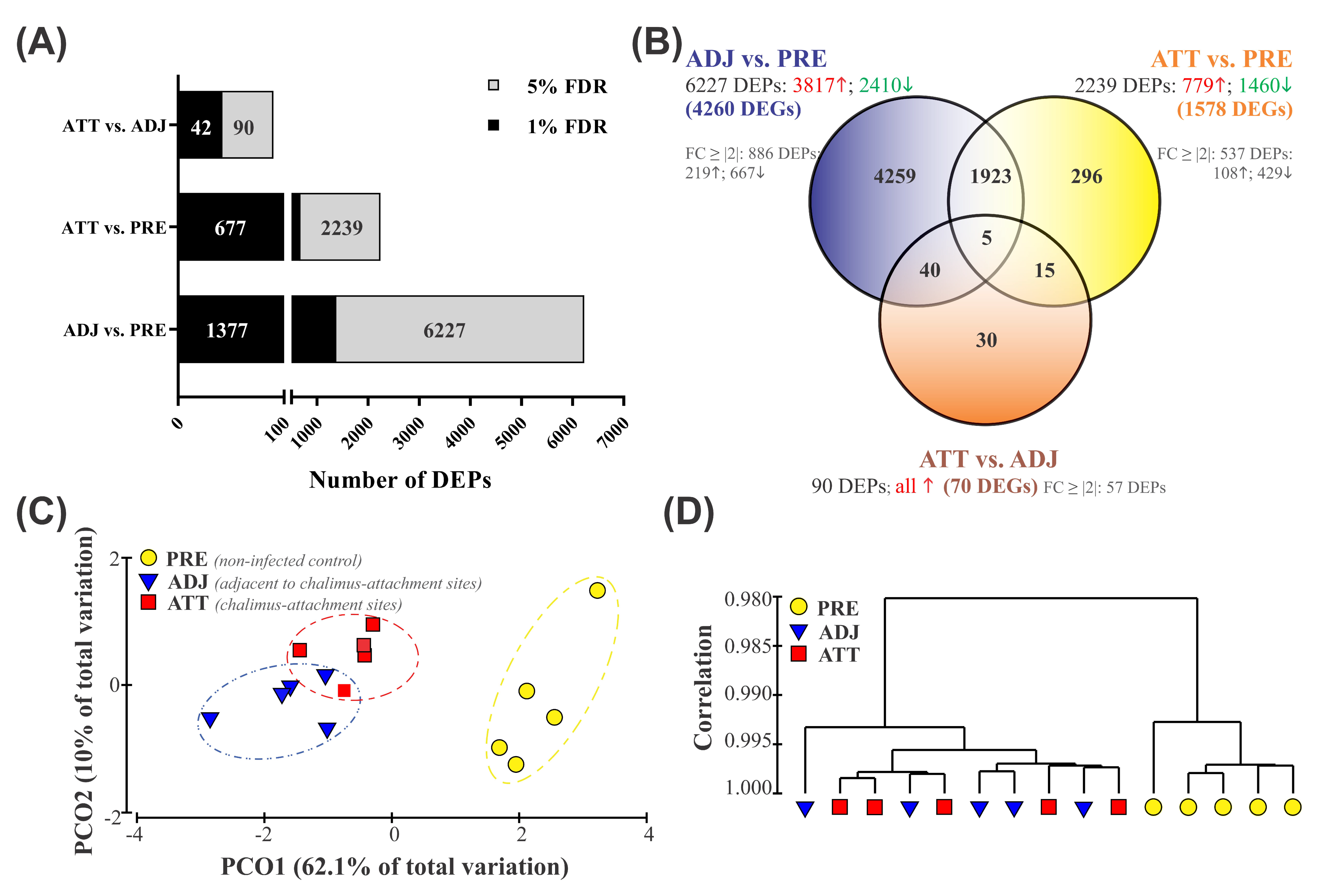
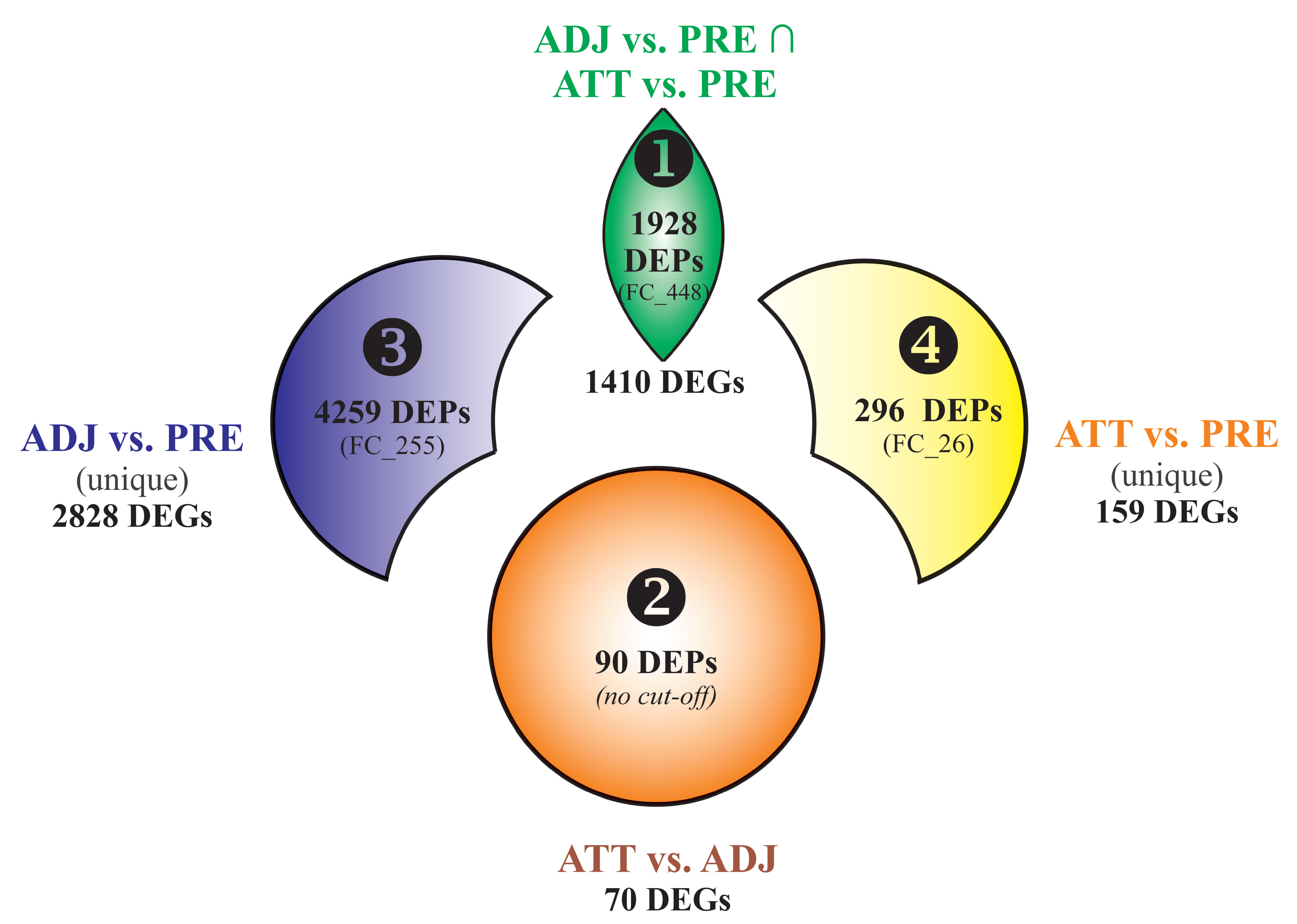
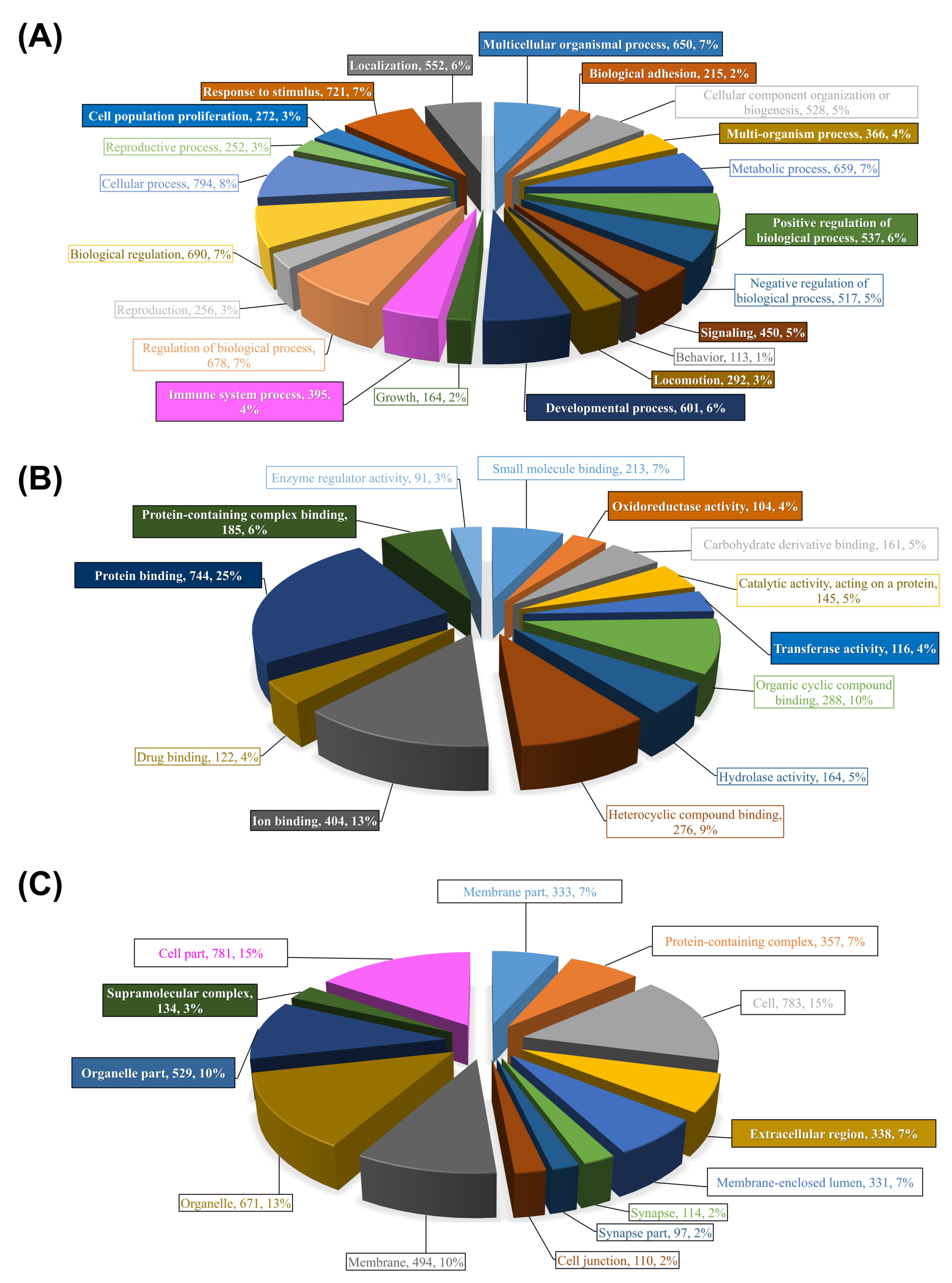

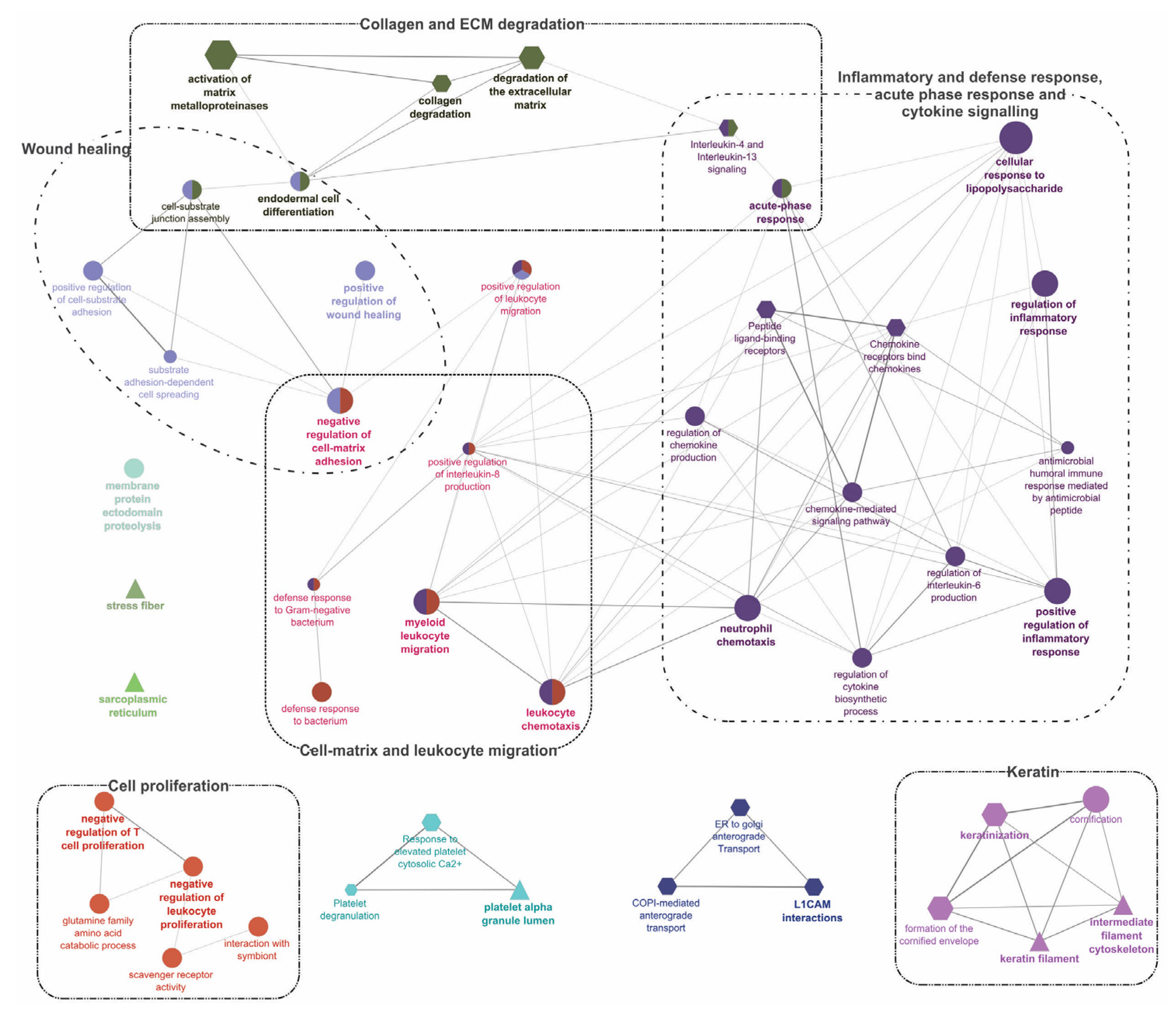
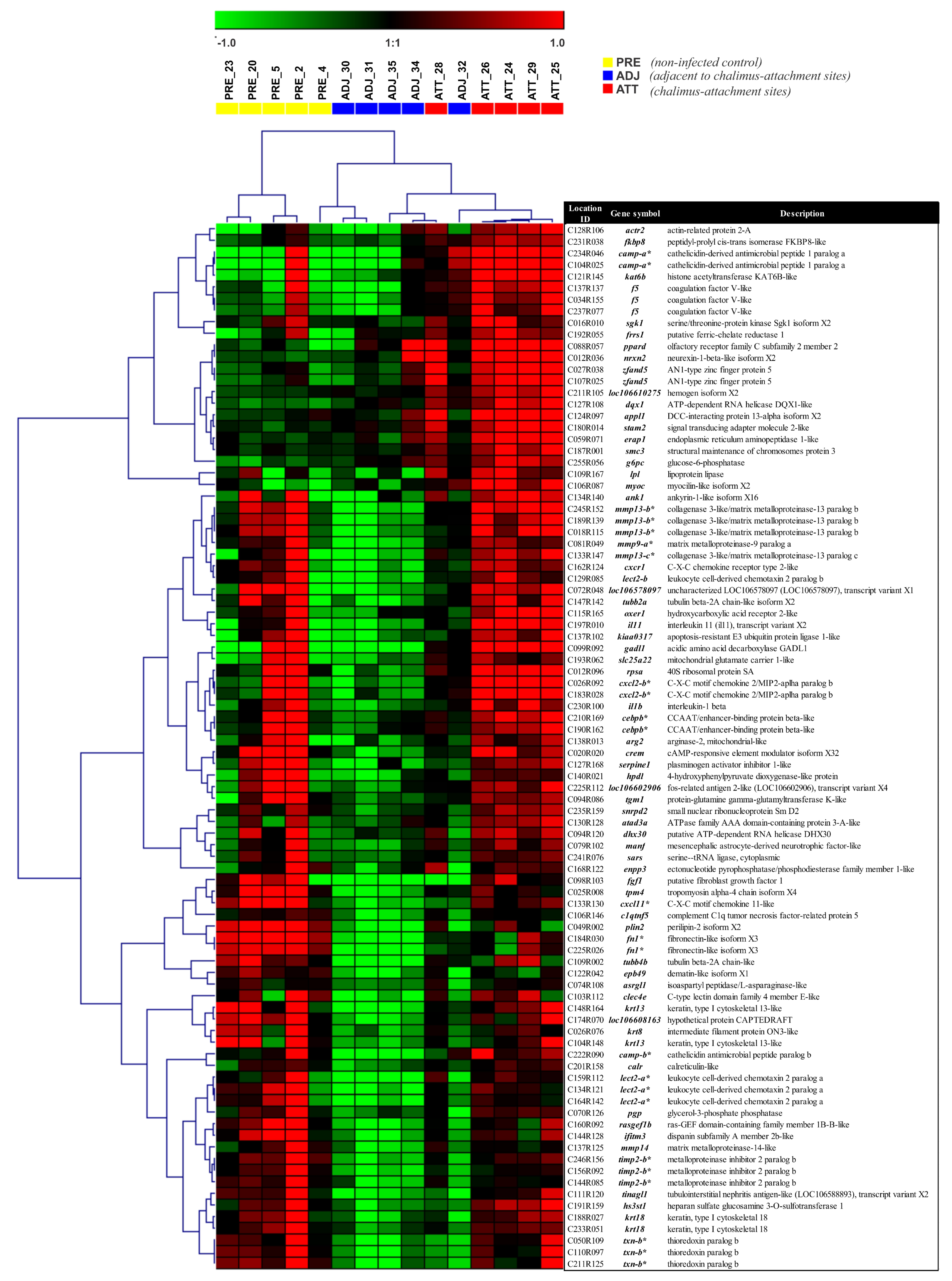
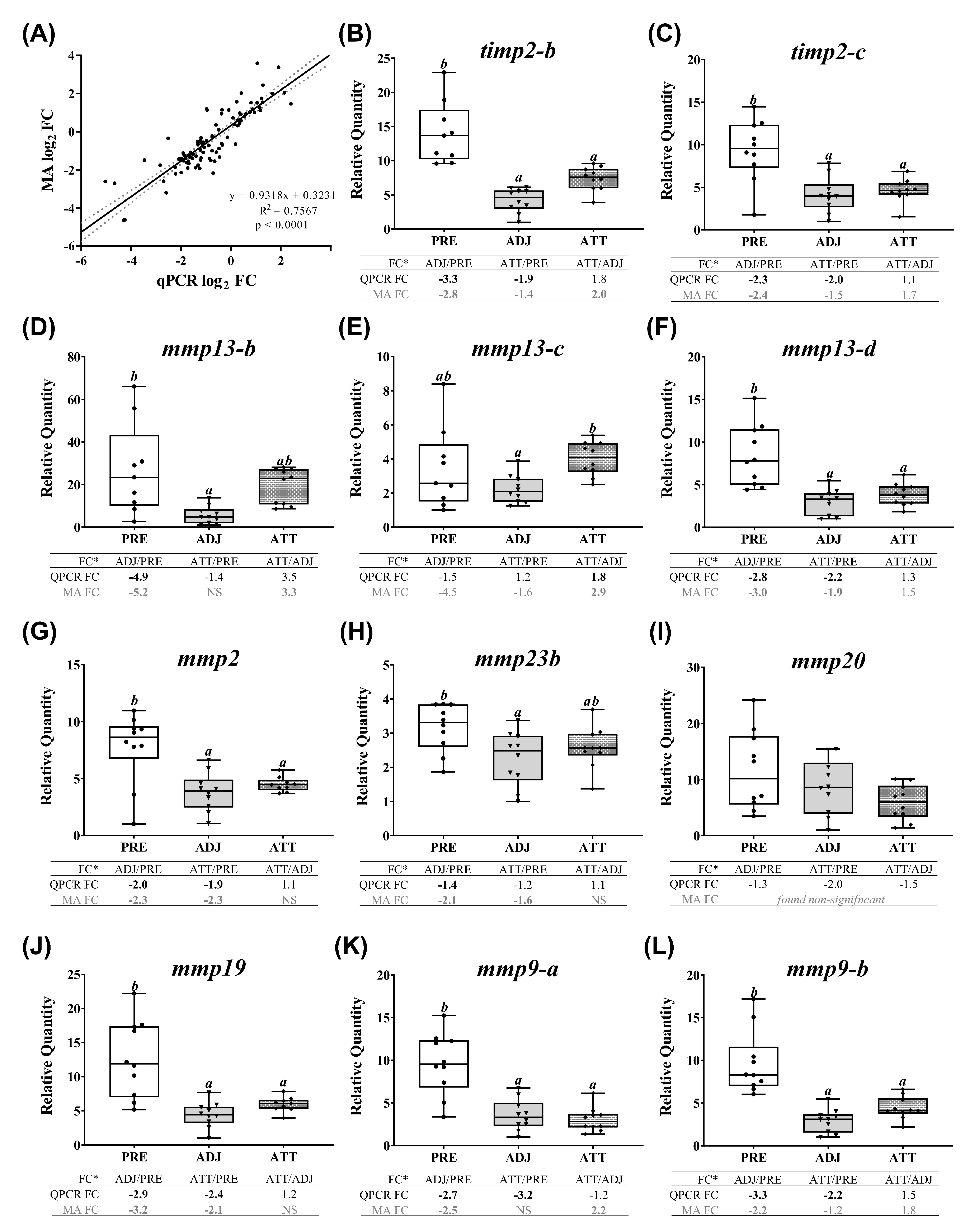


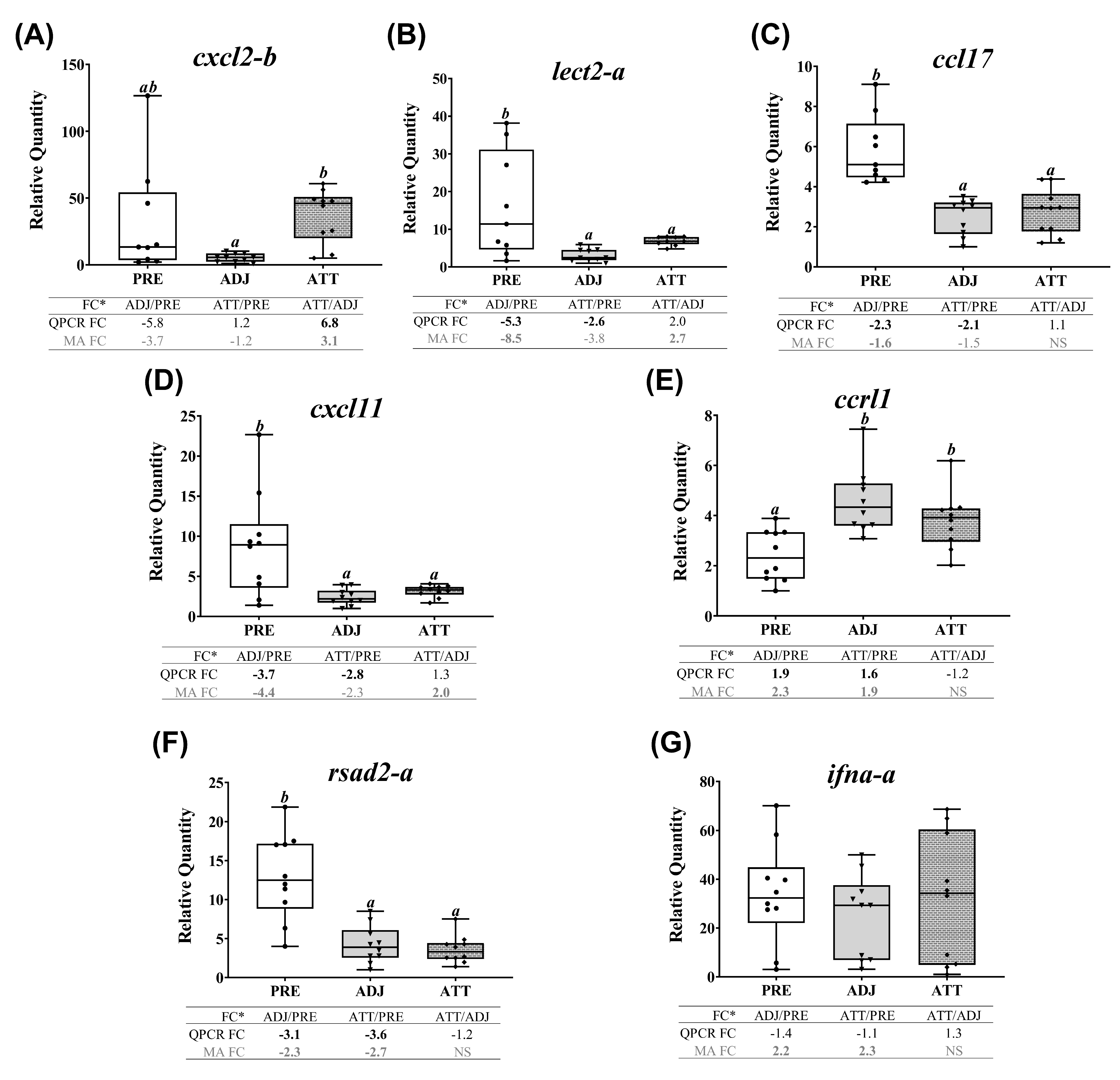
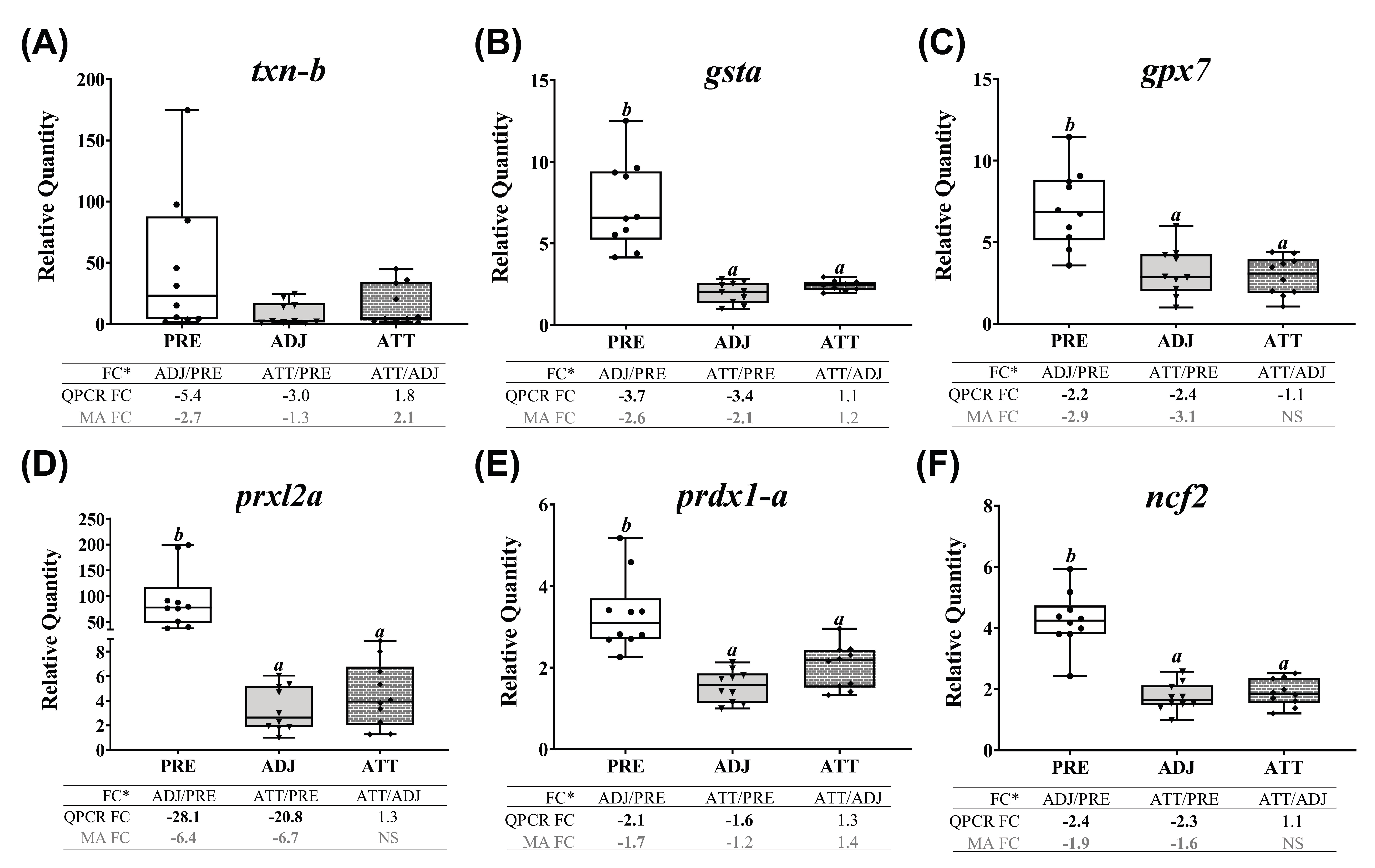
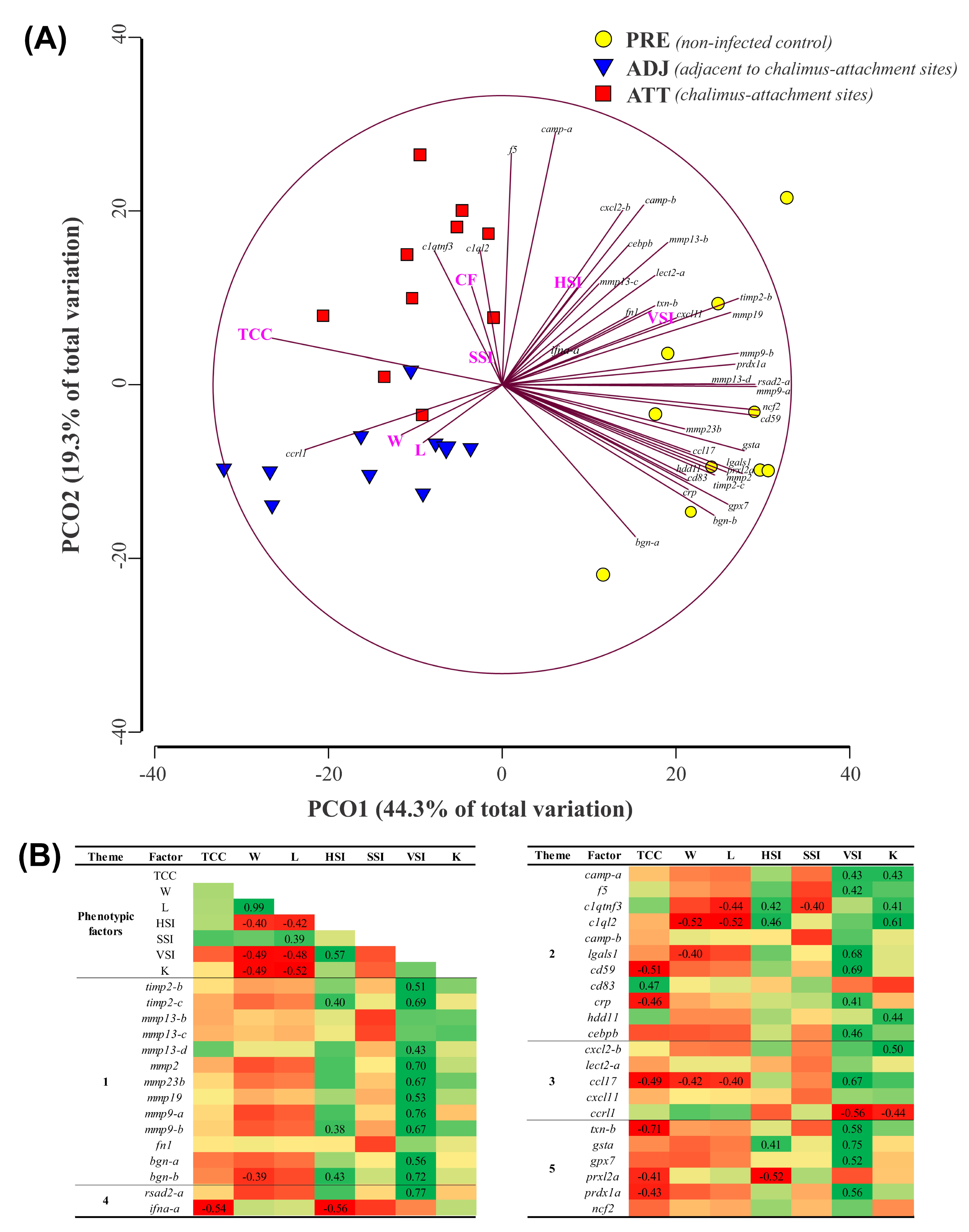

| Category | Probe ID (44K) 1 | Gene Symbol_v1 2 | Gene Description 3 | Fold-Changes 4 | Segment 5 | ||
|---|---|---|---|---|---|---|---|
| ADJ versus PRE | ATT versus PRE | ATT versus ADJ | (Figure 2) | ||||
| Transcription factors | C090R002 | hoxd12 | Homeobox protein Hox-D12a-like | −13.7 | −14.3 | NS | 1 |
| C180R160 | hoxd10 | Homeobox protein Hox-D10 | −3.1 | −2.8 | NS | 1 | |
| C072R152 | hoxa9 | Homeobox protein Hox-A9b-like | −2.6 | −2.0 | NS | 1 | |
| C191R067 | hoxc11 | Homeobox protein Hox-A11a-like | −2.2 | −2.2 | NS | 1 | |
| C072R1164 | hoxc9 | Homeobox protein Hox-C9 | 2.9 | 2.6 | NS | 1 | |
| C032R060 | hoxa5 | Homeobox protein Hox-A5 | 3.1 | 2.7 | NS | 1 | |
| C033R115 | hoxc6 | Homeobox protein Hox-C6-like | 3.1 | 3.0 | NS | 1 | |
| C190R1622 | cebpb* | CCAAT/enhancer-binding protein beta (C/EBP beta) | NS | NS | 2.0 | 2 | |
| C262R105 | gfi1b | Zinc finger protein Gfi−1b | 7.0 | 22.4 | NS | 1 | |
| C088R057 | ppard | Peroxisome proliferator activated receptor delta | NS | 29.9 | 8.7 | 2 | |
| Sugar and lipid metabolism | C149R1704 | cox6b1 | Cytochrome c oxidase subunit 6B1 | −3.8 | −3.0 | NS | 1 |
| C201R1002 | tkt | Transketolase | 2.3 | 1.9 | NS | 1 | |
| C255R056 | g6pc | Glucose-6-phosphatase | 1.3 | 2.2 | 1.6 | 1 | |
| C228R118 | aldoc | Fructose-bisphosphate aldolase C | 4.3 | 8.2 | NS | 1 | |
| C120R022 | nd1 | NADH dehydrogenase subunit 1 | 2.9 | 3.1 | NS | 1 | |
| C150R058 | mettl17 | Methyltransferase-like protein 17 | 3.9 | 9.4 | NS | 1 | |
| C138R1213 | gapdh | Glyceraldehyde-3-phosphate dehydrogenase | 2.5 | 2.9 | NS | 1 | |
| C217R012 | aloxe3 | Arachidonate Lipoxygenase 3 (Hydroperoxide isomerase) | 5.9 | 16.7 | NS | 1 | |
| Melanin biosynthesis | C178R076 | dct | L-dopachrome tautomerase-like | −20.9 | −18.2 | NS | 1 |
| C218R159 | tyrp1 | 5,6-dihydroxyindole-2-carboxylic acid oxidase | −11.8 | −13.1 | NS | 1 | |
| C217R115 | tyr | Tyrosinase | −9.9 | −11.2 | NS | 1 | |
| ECM degradation, tissue | C184R0187 | col10a1 | Collagen alpha-1(X) chain | −4.2 | −4.1 | NS | 1 |
| C199R006 | col6a1 | Collagen alpha-1(VI) chain | −2.8 | −2.6 | NS | 1 | |
| repair/remodeling, and wound | C114R0492 | col15a1 | Collagen alpha-1(XV) chain | −2.2 | −2.2 | NS | 1 |
| healing | C095R156 | lamc1 | Laminin subunit gamma-1 | −3.9 | NS | NS | 3 |
| C184R0302 | fn1* | Fibronectin | −3.7 | −1.8 | 2.0 | 1,2 | |
| C170R165 | bgn-a* | Biglycan paralog a | −2.5 | −2.6 | NS | 1 | |
| C237R076 | bgn-b* | Biglycan paralog b | −4.6 | −3.6 | NS | 1 | |
| C222R057 | dcn | Decorin | −1.8 | −2.4 | NS | 1 | |
| C265R1342 | htra1 | Serine protease HTRA1 | −2.2 | −2.1 | NS | 1 | |
| C240R103 | htra3 | Serine protease HTRA3 | −2.1 | −1.8 | NS | 1 | |
| C176R1514 | ctsb | Cathepsin B | −2.0 | NS | NS | 3 | |
| C200R1378 | anxa13 | Annexin A13 | −2.4 | −2.4 | NS | 1 | |
| C143R1655 | anxa2 | Annexin A2 | −2.4 | NS | NS | 3 | |
| C185R0983 | serpinh1 | 47 kDa HSP/collagen-binding protein | −2.3 | −2.2 | NS | 1 | |
| C015R046 | itga10 | Integrin alpha-10 | −2.6 | NS | NS | 3 | |
| C080R0812 | tgfbi | Transforming growth factor-beta-induced protein | −2.0 | −1.9 | NS | 1 | |
| C205R1352 | ctgf | Connective tissue growth factor (CCN family member 2) | −2.1 | NS | NS | 3 | |
| C098R103 | fgf1 | Fibroblast growth factor 1 | −11.8 | NS | 5.0 | 2 | |
| C081R049 | mmp9-a* | Matrix metalloproteinase-9 paralog a | −2.5 | NS | 2.2 | 2 | |
| C047R004 | mmp9-b* | Matrix metalloproteinase-9 paralog b | −2.2 | NS | NS | 3 | |
| C137R132 | mmp13-d* | Matrix metalloproteinase-13 (Collagenase 3) paralog d | −3.0 | −1.9 | NS | 1 | |
| C245R1523 | mmp13-b* | Matrix metalloproteinase-13 (Collagenase 3) paralog b | −5.2 | NS | 3.3 | 2 | |
| C133R147 | mmp13-c* | Matrix metalloproteinase-13 (Collagenase 3) paralog c | NS | NS | 2.9 | 2 | |
| C048R1628 | mmp2* | Matrix metalloproteinase-2 | −2.3 | −2.3 | NS | 1 | |
| C062R075 | mmp19* | Matrix metalloproteinase-19 | −3.2 | −2.1 | NS | 1 | |
| C099R050 | mmp23b* | Matrix metalloproteinase-23b | −2.1 | −1.6 | NS | 1 | |
| C246R1563 | timp2-b* | Metalloproteinase inhibitor 2 paralog b | −2.7 | NS | 1.9 | 2 | |
| C242R139 | timp2-c* | Metalloproteinase inhibitor 2 paralog c | −2.4 | NS | NS | 3 | |
| C135R154 | timp3 | Metalloproteinase inhibitor 3 | −3.9 | −2.5 | NS | 1, 3 | |
| Oxygen transport | C220R1344 | hba/hba4 | Hemoglobin subunit alpha (and -4) | −2.9 | −2.6 | NS | 1 |
| C171R16421 | hbb | Hemoglobin subunit beta | −3.2 | −3.0 | NS | 1 | |
| C088R0865 | alas2 | 5-aminolevulinate synthase | −2.5 | −2.3 | NS | 1 | |
| C255R1032 | cygb | Cytoglobin-2 | 2.0 | NS | NS | 3 | |
| Redox homeostasis | C104R146 | txndc5 | Thioredoxin domain-containing protein 5 | −2.4 | −1.8 | NS | 1 |
| C264R1092 | prxl2a* | Redox-regulatory protein fam213a (peroxiredoxin-like 2A) | −6.4 | −6.7 | NS | 1 | |
| C174R1432 | gpx7* | Glutathione peroxidase 7 | −2.9 | −3.1 | NS | 1 | |
| C210R1264 | gsta* | Glutathione S-transferase A-like | −2.6 | −2.1 | NS | 1 | |
| C115R1146 | ncf2* | Neutrophil cytosol factor 2-like isoform X2 | −1.9 | −1.6 | NS | 1 | |
| C211R1253 | txn-b* | Thioredoxin paralog b | −2.7 | NS | 2.2 | 2, 3 | |
| C115R1145 | prdx1-a* | Peroxiredoxin 1 paralog a | −1.7 | NS | NS | 3 | |
| C198R137 | fth1 | Ferritin heavy chain | −1.6 | NS | NS | 3 | |
| C123R0752 | frim† | Ferritin, middle subunit | −2.7 | NS | NS | 3 | |
| Category | Probe ID (44K) 1 | Gene Symbol_v1 2 | Gene Description 3 | Fold-Changes 4 | Segment 5 | ||
|---|---|---|---|---|---|---|---|
| ADJ versus PRE | ATT versus PRE | ATT versus ADJ | (Figure 2) | ||||
| Pattern recognition | C188R0745 | cd93 | Complement component C1q receptor | −2.1 | −1.7 | NS | 1 |
| receptors (PRRs) | C084R1092 | cd209 | CD209 antigen | −1.9 | −1.8 | NS | 1 |
| C126R092 | cd302 | CD302 molecule | −2.1 | −2.0 | NS | 1, 4 | |
| C220R1582 | mbl2 | Mannose-binding protein C | −2.4 | −2.4 | NS | 1 | |
| C001R1353 | mrc1 | Macrophage mannose receptor 1 | −1.8 | NS | NS | 3 | |
| C117R009 | clec4m | C-type lectin domain family 4 member M (CD209-like) | −2.0 | NS | NS | 3 | |
| C103R112 | clec4e | C-type lectin domain family 4 member E | −2.1 | NS | 2.6 | 2, 1 | |
| C089R09910 | lgals1* | Galectin-1 | −2.9 | −3.2 | NS | 1 | |
| Cytokine/chemokine | C180R124 | ccl4 | C-C motif chemokine 4 | −6.5 | −4.3 | NS | 1 |
| signaling | C203R129 | tgfb3 | Transforming growth factor beta-3 | NS | −1.6 | NS | 4 |
| C185R1654 | cmklr1 | Chemokine-like receptor 1 | −3.4 | −2.8 | NS | 1 | |
| C095R021 | ccl17* | C-C motif chemokine 17-like | −1.6 | NS | NS | 3 | |
| C111R068 | il1r2 | Interleukin-1 receptor type 2 | −2.4 | NS | NS | 3 | |
| C252R0962 | ccr4 | C-C chemokine receptor type 4 | −1.8 | NS | NS | 3 | |
| C159R1502 | il13ra2 | Interleukin-13 receptor subunit alpha-2 | 3.1 | 3.0 | NS | 1 | |
| C202R162 | ccrl1* | Chemokine receptor 4-like | 2.3 | 1.9 | NS | 1 | |
| C162R124 | cxcr1 | C-X-C chemokine receptor type 1 | −5.3 | NS | 2.5 | 2 | |
| C159R1122 | lect2-a* | Leukocyte cell-derived chemotaxin-2 paralog a | −8.2 | NS | 2.4 | 2 | |
| C133R130 | cxcl11* | C-X-C motif chemokine 11-like | −4.4 | NS | 2.0 | 2 | |
| C183R0282 | cxcl2-b* | C-X-C motif chemokine 2 (MIP2) paralog b | NS | NS | 3.1 | 2 | |
| C230R100 | il1b | Interleukin-1 beta | NS | NS | 2.2 | 2 | |
| C197R010 | il11 | Interleukin 11 | NS | NS | 3.7 | 2 | |
| Complement system | C070R1625 | cfh | Complement factor H | −2.9 | −2.8 | NS | 3, 1 |
| C195R1223 | cd59* | CD59 glycoprotein | −2.9 | −2.4 | NS | 1 | |
| C232R0832 | c4a | Complement C4 | −3.0 | −2.2 | NS | 1 | |
| C184R062 | cfd | Complement factor D | NS | −2.2 | NS | 4 | |
| C153R129 | c3ar1 | C3a anaphylatoxin chemotactic receptor | −2.6 | −2.2 | NS | 1 | |
| C073R0142 | c5ar1 | C5a anaphylatoxin chemotactic receptor 1 | −1.7 | NS | NS | 3 | |
| C191R156 | cfb | Complement factor B | 2.2 | 2.1 | NS | 1 | |
| Coagulation cascade | C089R005 | f3 | Coagulation factor III (tissue factor) | −3.9 | −2.3 | NS | 1 |
| (Some of these also take part in acute phase response (APR)) | C009R0783 | tfpi2 | Tissue factor pathway inhibitor 2 precursor | −3.3 | −2.8 | NS | 1 |
| C013R163 | f10 | Coagulation factor X | 2.1 | 1.7 | NS | 1 | |
| C137R1373 | f5* | Coagulation factor V | NS | NS | 2.5 | 2 | |
| C127R168 | serpine1 | Plasminogen activator inhibitor 1 | −5.5 | NS | 2.3 | 2 | |
| Inflammation and | C145R001 | crp* | C-reactive protein | −2.2 | −2.6 | NS | 1 |
| acute phase | C068R1542 | mdk | Midkine | −2.3 | −1.8 | NS | 1 |
| response (APR) | C254R103 | ptges | Prostaglandin E synthase | −2.0 | −1.7 | NS | 1 |
| C042R0873 | vcam1 | Vascular cell adhesion protein 1 | −2.4 | −1.6 | NS | 1 | |
| C003R128 | gpr44 | Prostaglandin D2 receptor 2 | 2.3 | NS | NS | 3 | |
| Antiviral response | C139R032 | rsad2-a* | Radical S-adenosyl methionine domain-containing protein 2 (Viperin) paralog a | −2.3 | −2.7 | NS | 1 |
| C080R0313 | ifi44 | Interferon-induced protein 44 (p44) (Microtubule-associated protein 44) | −1.8 | −2.3 | NS | 1,4 | |
| C055R128 | ifit5 | Interferon-induced protein with tetratricopeptide repeats 5 | −2.3 | −2.3 | NS | 1 | |
| C218R011 | ifna-a* | Interferon a3 paralog a | 2.2 | 2.3 | NS | 1 | |
| C168R125 | trim8 | E3 ubiquitin-protein ligase TRIM8 | −1.8 | −1.8 | NS | 1 | |
| C184R150 | trim58 | Zinc-binding protein A33 | −2.4 | −2.1 | NS | 1 | |
| Innate immunity | C024R014 | hdd11* | Putative defense protein Hdd11 | −24.9 | −24.6 | NS | 1 |
| (general) | C164R1253 | cd99 | CD99 antigen-like protein 2 | −2.4 | −2.7 | NS | 1 |
| C029R1162 | cd83-a* | CD83 antigen paralog a | −1.7 | −1.7 | NS | 1 | |
| C200R158 | c1qtnf6 | Complement C1q tumor necrosis factor-related protein 6 | −2.3 | −2.5 | NS | 1 | |
| C230R128 | lbp | Lipopolysaccharide-binding protein (LBP) | −1.9 | −1.9 | NS | 1 | |
| C092R0997 | litaf | Lipopolysaccharide-induced tumor necrosis factor-alpha | −1.7 | −1.8 | NS | 1 | |
| C107R1233 | c1qbp | Complement component 1 Q subcomponent-binding protein, mitochondrial | −1.9 | NS | NS | 3 | |
| C121R047 | tnfrsf11b | Tumor necrosis factor receptor superfamily member 11B | NS | −2.1 | NS | 4 | |
| C076R108 | fgl1 | Fibrinogen-like protein 1 | −3.9 | −2.4 | NS | 1 | |
| C234R046 | camp-a* | Cathelicidin antimicrobial peptide paralog a | NS | 2.9 | 4.0 | 2 | |
| C222R090 | camp-b* | Cathelicidin antimicrobial peptide paralog b | −2.7 | NS | 2.9 | 2 | |
| C098R103 | fgf1 | Fibroblast growth factor 1 | −11.8 | NS | 5.0 | 2 | |
| C138R013 | arg2 | Arginase-2 | NS | NS | 1.9 | 2 | |
| C249R1332 | c1ql2* | Complement C1q-like protein 2 | NS | 10.3 | NS | 4 | |
| C234R0425 | nlrc3 | NLR family CARD domain-containing protein 3 | 1.7 | 2.2 | NS | 3, 1 | |
| C095R050 | c1qtnf3* | Complement C1q tumor necrosis factor-related protein 3 | 4.1 | 12.0 | NS | 1, 4 | |
| Adaptive immunity | C243R111 | hlab | HLA (MHC) class I histocompatibility antigen, B-51 alpha chain | −2.3 | −2.6 | NS | 1 |
| C211R164 | hlah | HLA (MHC) class I histocompatibility antigen, alpha chain H | −3.7 | −3.8 | NS | 1 | |
| C141R11418 | b2m | Beta-2-microglobulin | −1.6 | −1.7 | NS | 1 | |
| C263R031 | iglc3 | Immunoglobulin lambda constant 3 | −3.2 | −3.8 | NS | 1 | |
| C250R1447 | fcer1g | High affinity immunoglobulin epsilon receptor subunit gamma | −1.7 | −1.7 | NS | 1 | |
| C229R1696 | loc106606767 | Immunoglobulin mu chain C region | −5.0 | NS | NS | 3 | |
| Functional Theme 1 | Gene Description 2 | Gene Symbol_v1 3 | General Function 4 | Enriched GO Terms Associated 5 | Segment in MA 6 | Pathway Figure(s) |
|---|---|---|---|---|---|---|
| 1. ECM degradation, tissue repair/remodeling and wound healing | TIMP metalloproteinase inhibitor 2 | timp2 | Modulating the activity of several MMPs | Activation of MMPs, Degradation of the ECM | 2 | Figure 5 |
| collagenase 3-like/matrix metalloproteinase-13 | mmp13 | ECM catabolism, cartilage degradation, tissue remodeling, wound healing | Activation of MMPs, Degradation of the ECM, Collagen degradation/catabolic process | 2 | Figure 4B, Figure 5 | |
| matrix metalloproteinase 2 (72 kDa type IV collagenase) | mmp2 | ECM catabolism, tissue repair/remodeling, inflammation | Extracellular space, ECM organization, Degradation of the ECM | 1 | Figure 4B | |
| matrix metalloproteinase-23 | mmp23b | ECM catabolism | Extracellular space, ECM organization, Collagen-containing ECM | 1 | Figure 4B, Supp. Figure S2B | |
| matrix metalloproteinase-20 # | mmp20 | ECM catabolism | Not identified by SAM | - | - | |
| matrix metalloproteinase-19 | mmp19 | ECM catabolism | Extracellular space, ECM organization, Degradation of the ECM | 1 | Figure 4B | |
| matrix metalloproteinase-9 | mmp9 | ECM catabolism, leukocyte migration | Activation of MMPs, Degradation of the ECM, Collagen degradation/catabolic process, Regulation of inflammatory response | 2, 3 | Figure 5, Supp. Figure S2B | |
| fibronectin | fn1 | ECM assembly, cell motility, adhesion, wound healing | Extracellular space, ECM organization, Acute-phase response | 1, 2 | Figure 4B, Figure 5 | |
| biglycan-like | bgn | Collagen fiber assembly, ECM organization, matrix mineralization | Extracellular space, ECM organization, Collagen-containing ECM | 1 | Figure 4B | |
| 2. Immunity and defense (Not including antiviral response) | cathelicidin | camp | Antibacterial activity | Defense response to bacterium, Antimicrobial humoral immune response mediated by antimicrobial peptide | 2 | Figure 5 |
| beta-galactoside-binding lectin | lgals1 | Regulating apoptosis, cell proliferation and cell differentiation | Extracellular space, Regulation of immune system process | 1 | Figure 4B | |
| CD59 glycoprotein | cd59 | Complement MAC inhibition | Regulation of immune system process, Cell surface receptor signaling pathway | 1 | Figure 4B | |
| CD83 | cd83 | Antigen presentation and lymphocyte activation | Regulation of immune system process, Leukocyte activation, Positive regulation of immune system process | 1 | Figure 4B | |
| complement C1q tumor necrosis factor-related protein 3 | c1qtnf3 | Regulatory role in immune system | $ Negative regulation of inflammatory response, Positive regulation of cytokine secretion, Immune system process | 1 | Figure 4A | |
| complement C1q-like protein 2 | c1ql2 | Regulate excitatory synapses | $ Extracellular region, Immune system process | 4 | Supp. Figure S3A | |
| C-reactive protein | crp | Inflammation, acute phase response, defense | Leukocyte mediated immunity, Regulation of immune system process, Defense response | 1 | Figure 4B | |
| coagulation factor V-like | f5 | Central regulator of hemostasis | Platelet alpha granule lumen, Platelet degranulation | 2 | Figure 5 | |
| putative defense protein Hdd11 | hdd11 | Putative antimicrobial activity | $ Defense response to other organism, Response to stimulus, Innate immune response | 1 | Figure 4B | |
| CCAAT/enhancer-binding protein beta-like | cebpb | Transcription factor for immune and inflammatory genes | Defense response to bacterium, Regulation of cytokine biosynthetic process, Acute-phase response | 2 | Figure 5 | |
| 3. Chemotaxis and signaling | C-X-C motif chemokine 2/MIP2-aplha/permeability factor 2-like | cxcl2 | Hematoregulatory chemokine | Myeloid leukocyte migration, Neutrophil chemotaxis, Chemokine-mediated signaling pathway | 2 | Figure 5 |
| leukocyte cell derived chemotaxin 2 | lect2 | Chemotactic activity, chondrocyte proliferation | $ Response to stimulus, Immune system process | 2 | Figure 5 | |
| C-C motif chemokine 17-like | ccl17 | T-lymphocytes trafficking and activation | Response to cytokine, Cellular response to cytokine stimulus | 3 | Figure 2B | |
| chemokine receptor 4-like | ccrl1 | Regulator of chemotaxis | $ Response to stimulus, Immune system process | 1 | Figure 4B | |
| C-X-C motif chemokine 11-like | cxcl11 | Chemotactic for activated T-cells, neutrophils or monocytes | Myeloid leukocyte migration, Neutrophil chemotaxis, Chemokine-mediated signaling pathway | 2 | Figure 5 | |
| 4. Antiviral response | radical S-adenosyl methionine domain-containing protein 2, alias (viperin) | rsad2 | Antiviral | Immune system, Regulation of immune system process | 1 | Figure 4B |
| interferon a3 | ifna* | Antiviral | Immune system process, Response to stimulus | 1 | Figure 4A | |
| 5. Antioxidant activity and redox homeostasis | thioredoxin | txn | Redox homeostasis | $ Antioxidant activity, Response to oxygen levels, Response to stress | 2, 3 | Figure 5, Supp. Figure S2B |
| glutathione S-transferase A | gsta | Redox homeostasis | $ Response to stress/chemical | 1 | Figure 4B | |
| glutathione peroxidase 7 | gpx7 | Redox homeostasis | $ Antioxidant activity, Response to stimulus | 1 | Figure 4B | |
| redox-regulatory protein fam213a (peroxiredoxin-like 2A) | prxl2a | Redox homeostasis | $ Antioxidant activity, Regulation of immune system process | 1 | Figure 4B | |
| peroxiredoxin 1 | prdx1 | Redox homeostasis | $ Removal of superoxide radicals, Response to oxidative stress | 3 | Figure 2B | |
| neutrophil cytosol factor 2-like isoform X2 | ncf2 | NADPH oxidase, redox homeostasis | $ Superoxide-generating NADPH oxidase activator activity, Respiratory burst | 1 | Figure 4B |
© 2020 by the authors. Licensee MDPI, Basel, Switzerland. This article is an open access article distributed under the terms and conditions of the Creative Commons Attribution (CC BY) license (http://creativecommons.org/licenses/by/4.0/).
Share and Cite
Umasuthan, N.; Xue, X.; Caballero-Solares, A.; Kumar, S.; Westcott, J.D.; Chen, Z.; Fast, M.D.; Skugor, S.; Nowak, B.F.; Taylor, R.G.; et al. Transcriptomic Profiling in Fins of Atlantic Salmon Parasitized with Sea Lice: Evidence for an Early Imbalance Between Chalimus-Induced Immunomodulation and the Host’s Defense Response. Int. J. Mol. Sci. 2020, 21, 2417. https://doi.org/10.3390/ijms21072417
Umasuthan N, Xue X, Caballero-Solares A, Kumar S, Westcott JD, Chen Z, Fast MD, Skugor S, Nowak BF, Taylor RG, et al. Transcriptomic Profiling in Fins of Atlantic Salmon Parasitized with Sea Lice: Evidence for an Early Imbalance Between Chalimus-Induced Immunomodulation and the Host’s Defense Response. International Journal of Molecular Sciences. 2020; 21(7):2417. https://doi.org/10.3390/ijms21072417
Chicago/Turabian StyleUmasuthan, Navaneethaiyer, Xi Xue, Albert Caballero-Solares, Surendra Kumar, Jillian D. Westcott, Zhiyu Chen, Mark D. Fast, Stanko Skugor, Barbara F. Nowak, Richard G. Taylor, and et al. 2020. "Transcriptomic Profiling in Fins of Atlantic Salmon Parasitized with Sea Lice: Evidence for an Early Imbalance Between Chalimus-Induced Immunomodulation and the Host’s Defense Response" International Journal of Molecular Sciences 21, no. 7: 2417. https://doi.org/10.3390/ijms21072417
APA StyleUmasuthan, N., Xue, X., Caballero-Solares, A., Kumar, S., Westcott, J. D., Chen, Z., Fast, M. D., Skugor, S., Nowak, B. F., Taylor, R. G., & Rise, M. L. (2020). Transcriptomic Profiling in Fins of Atlantic Salmon Parasitized with Sea Lice: Evidence for an Early Imbalance Between Chalimus-Induced Immunomodulation and the Host’s Defense Response. International Journal of Molecular Sciences, 21(7), 2417. https://doi.org/10.3390/ijms21072417




